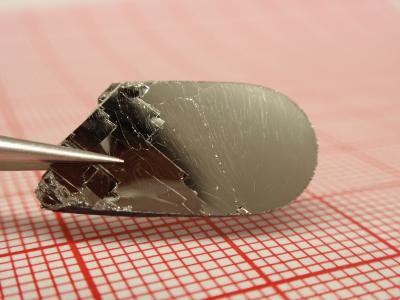Ames Laboratory scientists gain insight on mechanism of unconventional superconductivity

A crystal sample of one of the iron-based unconventional superconductors studied by Ames Laboratory scientists. Their systematic investigation of this class of superconductors may lead to the creation of new materials with unique superconducting properties. Credit: U.S. Department of Energy, Ames Laboratory
Researchers combined innovative crystal growth, highly sensitive magnetic measurements, and the controlled introduction of disorder through electron bombardment to create and study an entire range of compositions within a class of iron-based superconductors. They found that the key fundamental properties–transition temperature and magnetic field penetration depth — of these complex superconductors were dependent on composition and the degree of disorder in the material structure.
“This was a systematic approach to more fully understand the behavior of unconventional superconductors,” said Ruslan Prozorov, Ames Laboratory faculty scientist and professor in the Department of Physics and Astronomy at Iowa State University. “We found that some proposed models of unconventional superconductivity in these iron-based compounds were compatible with our results, and this study further limited the possible theoretical mechanisms of superconductivity.
“Researchers combined innovative crystal growth, highly sensitive magnetic measurements, and the controlled introduction of disorder through electron bombardment to create and study an entire range of compositions within a class of iron-based superconductors. They found that the key fundamental properties–transition temperature and magnetic field penetration depth — of these complex superconductors were dependent on composition and the degree of disorder in the material structure.
“This was a systematic approach to more fully understand the behavior of unconventional superconductors,” said Ruslan Prozorov, Ames Laboratory faculty scientist and professor in the Department of Physics and Astronomy at Iowa State University. “We found that some proposed models of unconventional superconductivity in these iron-based compounds were compatible with our results, and this study further limited the possible theoretical mechanisms of superconductivity.”
That information will also serve as a resource for future research into unconventional superconductors.
“This study fleshed out the knowledge of a class of materials more completely and in a way that will be helpful to the scientific community as they search for high temperature superconductors. Knowing how transition temperature is affected by composition, magnetic field and structural disorder gives science a better idea of where to dig–it contributes to the goal of discovery by design, creating materials that do exactly what we want them to do,” said Prozorov.
###
The research was conceived and conducted by the Ames Laboratory team, with the Department of Physics and Astronomy at Iowa State University. Electron irradiation was performed at the Laboratoire des Solides Irradiés École Polytechnique, CNRS, France. Theoretical support was provided by the Joint Institute of Computational Sciences, University of Tennessee, Knoxville, the Department of Physics, University of Florida, and the Center for Nanophase Materials Sciences, a DOE Office of Science User Facility at Oak Ridge National Laboratory. It is discussed in a paper published in Science Advances, “Energy Gap Evolution Across the Superconductivity Dome in Single Crystals of (Ba1-x Kx)Fe2As2”, and co-authored by Kyuil Cho, M. Ko?czykowski, S. Tekowijoyo, M.A. Tanatar, Y. Liu, T.A. Lograsso, W.E. Straszheim, V. Mishra, S. Maiti, P.J. Hirschfeld, and R. Prozorov
Ames Laboratory is a U.S. Department of Energy Office of Science national laboratory operated by Iowa State University. Ames Laboratory creates innovative materials, technologies and energy solutions. We use our expertise, unique capabilities and interdisciplinary collaborations to solve global problems.
DOE's Office of Science is the single largest supporter of basic research in the physical sciences in the United States, and is working to address some of the most pressing challenges of our time. For more information, please visit science.energy.gov.
Media Contact
All latest news from the category: Physics and Astronomy
This area deals with the fundamental laws and building blocks of nature and how they interact, the properties and the behavior of matter, and research into space and time and their structures.
innovations-report provides in-depth reports and articles on subjects such as astrophysics, laser technologies, nuclear, quantum, particle and solid-state physics, nanotechnologies, planetary research and findings (Mars, Venus) and developments related to the Hubble Telescope.
Newest articles

Superradiant atoms could push the boundaries of how precisely time can be measured
Superradiant atoms can help us measure time more precisely than ever. In a new study, researchers from the University of Copenhagen present a new method for measuring the time interval,…

Ion thermoelectric conversion devices for near room temperature
The electrode sheet of the thermoelectric device consists of ionic hydrogel, which is sandwiched between the electrodes to form, and the Prussian blue on the electrode undergoes a redox reaction…

Zap Energy achieves 37-million-degree temperatures in a compact device
New publication reports record electron temperatures for a small-scale, sheared-flow-stabilized Z-pinch fusion device. In the nine decades since humans first produced fusion reactions, only a few fusion technologies have demonstrated…





















